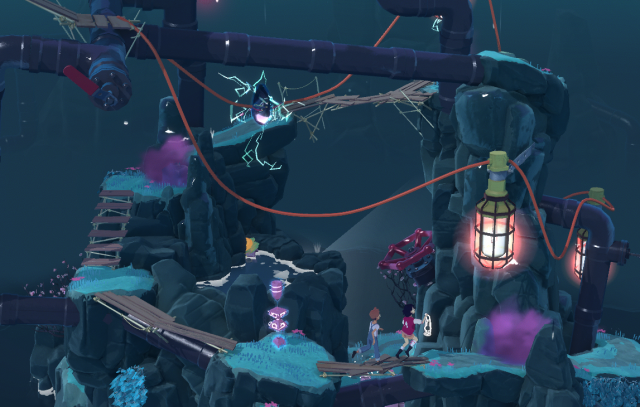Short description of The Gardens Between:
The Gardens Between is an adventure-puzzle game that takes players through a story about a pair of friends, Arina and Frendt, and their precious moments spent together. At each level, we get to see a significant memory from their past.
The gameplay is minimalistic, with simple controls. Players can only choose to move forwards and backwards in time and interact with certain items in the environment using the spacebar. Nonetheless, the puzzles have a certain level of difficulty in them and only get more difficult with each passing level.

Website link: http://thegardensbetween.com/
Analysis of game:
Mechanics: As the game has very little controls, the mechanics behind it are simple and the developers have executed it well. Players only have one clearly defined goal, which is to clear each level by lighting up the gate. The only thing I got frustrated about was one level where we had to track which of the many cubes bouncing all over the map carried our lantern. As the camera cannot be moved by the player themselves, there are many times where the cubes are blocked by the environment and when they re-emerge, they have switched places. I later found out that if we pause at the right moment, we can just see which ones have switched just before they are out of view and predict their movement when they re-emerge. In hindsight, that might have been intentionally done by the developers to make the game more challenging and to encourage us to think of different ways to solve the level.
Story: The story in the game is like a puzzle in its own right. It is pre-scripted but there is neither narration nor dialogue between the two characters so players have to figure it out on their own. I, personally, found it rather enjoyable to guess the plot with each passing memory that the game presents us with.
Aesthetics: The game is visually stunning and won the 2018 IGF awards for Excellence in Visual Art because of that. I think the art style of the game inspires a feeling of wonder and delight to anyone that first lay their eyes on it. That adds to the effect of feeling like we are transported into a dream-like world every time we play it.
Technology: As the controls are simple and the game is not too graphically demanding, it is highly accessible, available on all major platforms and even on phones.
Lens #2: The Lens of Surprise: The game definitely has interesting surprises. As the player is given very little control over the characters themselves, a large part of the gameplay relies on pausing at the right time and changing the environment to proceed. The way one can change the environment varies every level and there is an element of surprise at every level. For example, in one of the levels, we had to power some lightbulbs. That particular level truly stumped me, I kept going back in time, and then forwards again just trying to see if I’ve missed something. In the end, I solved it accidentally by rewinding time, back to where the characters were trying to cross a bridge and wait there for a droplet of water to land between two open electricity pipes. I had not even thought that that droplet of water had any significance and all these puzzles really make me pay a lot more attention to the environment.

Lens #31: The Lens of Challenge: Like most puzzle games, the game gets increasingly more challenging as one progresses. Keeping in mind that the difficulty of a game is subjective, I think that the game is quite balanced (it is not too difficult that it makes me want to give up and search for the answer online and also not too easy that it makes me bored) and I like the linearity of the difficulty progression. There are no dramatic difficulty spikes, the levels build up in difficulty in a very gradual manner.
Lens #64: The Lens of Projection: The portrayal of the characters is realistic; they emerge into the dream-like world full of wonder and bewilderment which echoes the player’s feelings. They are fuelled by curiosity and constantly fiddle with random objects that are on their path, which is something that I feel players can relate to when they are thrust into a world like that. However, as the story is pre-scripted and there is only one way to solve every level, there is little players can actually do to manipulate and change the outcomes so it feels like one is watching the story from an outsider’s point of view. To add on, as the story is not immediately clear, it keeps the player guessing what each level represents. Because of that, I find it difficult to project my imaginations into the game.
Lens #77: The Lens of Character Traits: The characters in the game have personalities that are very distinct from each other. As there is no dialogue in the game, these personality traits are only shown through actions alone. When the characters move they do not always keep the same pace, the two characters get distracted by various things in the environment, they run when they are excited, they move much slower when they are walking over a precarious bridge, etc. all these make the characters feel more human. I particularly like how easy it is to tell their character traits like how Arina almost always leads the way but will often wait for Frendt when he gets distracted or too scared to move forward. It makes it easy to associate Ariana as the brave one, while Frendt as the curious one which making them more impressionable to me.
